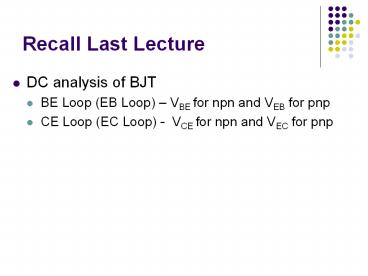Recall Last Lecture - PowerPoint PPT Presentation
1 / 15
Title:
Recall Last Lecture
Description:
Recall Last Lecture DC analysis of BJT BE Loop (EB Loop) VBE for npn and VEB for pnp CE Loop (EC Loop) - VCE for npn and VEC for pnp DC analysis of BJT When node ... – PowerPoint PPT presentation
Number of Views:107
Avg rating:3.0/5.0
Title: Recall Last Lecture
1
Recall Last Lecture
- DC analysis of BJT
- BE Loop (EB Loop) VBE for npn and VEB for pnp
- CE Loop (EC Loop) - VCE for npn and VEC for pnp
2
- DC analysis of BJT
- When node voltages are known, branch current
equations can be used.
(Va Vb) / R I
3
BJT Circuits at DC
? 0.99
KVL at BE loop 0.7 IERE 4 0 IE 3.3 /
3.3 1 mA Hence, IC ? IE 0.99 mA IB
IE IC 0.01 mA
KVL at CE loop ICRC VCE IERE 10 0
VCE 10 3.3 4.653 2.047 V
4
BJT Circuits at DC
? 0.99
5
LOAD LINE AND VOLTAGE TRANSFER CHARACTERISTIC
6
- Load Line and Voltage Transfer Characteristic can
be used to visualize the characteristic of the
transistor circuits.
7
LOAD LINE
8
Input Load Line IB versus VBE Derived using
B-E loop
- The input load line is obtained from Kirchhoffs
voltage law equation around the B-E loop, written
as follows
VBE VBB IBRB 0
- Both the load line and the quiescent base current
change as either or both VBB and RB change.
9
For example
? 200
- The input load line is essentially the same as
the load line characteristics for diode circuits.
VBE 4 IB(220k) 0
y mx c
- IBQ 15 µA
10
Output Load Line IC versus VCE Derived using
C-E loop
- For the C-E portion of the circuit, the load line
is found by writing Kirchhoffs voltage law
around the C-E loop. We obtain
11
For example
y mx c
? 200
- To find the intersection points setting IC 0,
- VCE VCC 10 V
- setting VCE 0
- IC VCC / RC 5 mA
Q-point is the intersection of the load line with
the iC vs vCE curve, corresponding to the
appropriate base current
12
Example Calculation and Load Line Calculate
the characteristics of a circuit containing an
emitter resistor and plot the output load line.
For the circuit, let VBE (on) 0.7 V and ß
75.
13
Load Line
Use KVL at B-E loop
14
Use KVL at C-E loop to plot the load line
15
IB 75.1 ?A































